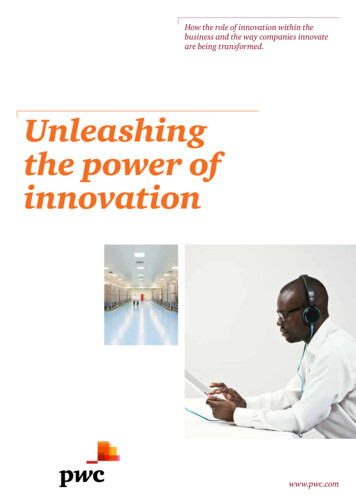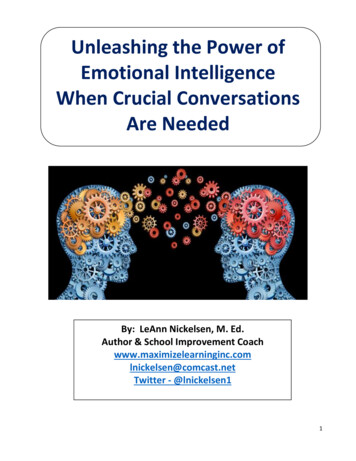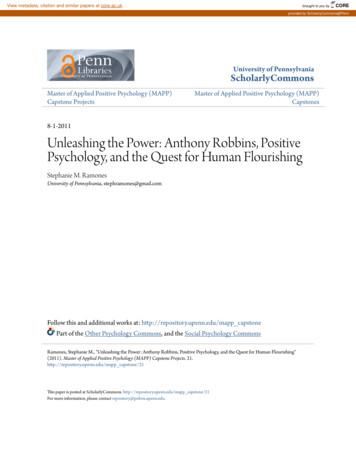
Transcription
Unleashing the Powerof Innovation forAssistive TechnologyRe-published with permission fromAmerican Institutes for Research
Unleashing the Powerof INNOVATION forAssistive TechnologyNational Center for Technology Innovation www.NationalTechCenter.org
Now is the time to take the leadand demonstrate powerful innovationsfor individuals with disabilitiesthat create new solutionsfor students, teachers, andservice providers.About the AuthorsThis brief was written by Tracy Gray, Ph.D., Director; Heidi Silver-Pacuilla, Ph.D., DeputyDirector; Cynthia Overton, Ph.D., Senior Research Analyst, and Alise Brann, M.S. Ed., Ed.S.,Research Analyst, of the National Center for Technology Innovation.Suggested CitationGray, T., Silver Pacuilla, H., Overton, C., & Brann, A. (2010, January). Unleashing the power ofinnovation for assistive technology. Washington, DC: American Institutes for Research.About the National Center for Technology InnovationThe National Center for Technology Innovation (NCTI), established in 2001, advances learningopportunities for all students, with a special focus on students with disabilities, by fosteringtechnology innovation. NCTI offers technical assistance to facilitate growth and sustainabilityof learning and assistive technologies. The Center is funded by the Office of Special EducationPrograms at the U.S. Department of Education and is located at the American Institutesfor Research in Washington, DC. The contents of this brief were developed under a grant(PR/Award #H327Z060003) from the U.S. Department of Education. However, these contentsdo not necessarily represent the policy of the U.S. Department of Education, and you shouldnot assume endorsement by the Federal Government.1000 Thomas Jefferson St, NW Washington, DC 20007 Phone: (202) 403-5323 Fax: (202) 403-5001 Email: ncti@air.org
An Issue Brief from theNational Center for Technology InnovationThe unprecedented increases in federal funding, coupled with new guidance from theU.S. Department of Education, school district purchasing power, and developments inconsumer electronics, present an unparalleled opportunity to unleash the creative powerof innovation to meet the needs of all students, particularly those with disabilities.The American Recovery and Reinvestment Act (ARRA) and new Administration prioritiespresent the field of educational and assistive technology (AT) researchers, developers,and vendors with new and exciting possibilities. The confluence of federal stimulusmoney and guidance from the U.S. Department of Education, Officeof Special Education Programs (OSEP) to school districts to considerInnovationinvesting in “state-of-the-art assistive technology and training” affordsis a newthe field a rare opportunity to define and shape what state-of-the-artassistive technology can be.approach that“The National Center for Technology Innovation (NCTI), funded byOSEP, serves our stakeholders by providing a better understandingof the Administration’s priorities and goals and offering guidanceto make wise technology purchases and development decisions.This Issue Brief, Unleashing the Power of Innovation for AssistiveTechnology, harnesses the thinking of our stakeholders and theliterature in the educational and assistive technology field to provideinsight for current and future investment, development, and research.brings mprovedresults .a product,platform,process,or idea.”—Smith, 2009The Policy landscapeARRA funds plus the U.S. Department of Education’s core reforms are expected to transform and reinvigoratepublic education throughout the nation. Additional federal initiatives, such as the Serve America Act andthe Social Innovation Fund, “give us a rare opportunity to move beyond some of the barriers to innovation ineducation” (Smith, 2009, p. 7).ARRA funds from the Department are governed by four broad principles: (a) spend funds quickly to save andcreate jobs; (b) improve student achievement through school improvement and reform; (c) ensure transparency,reporting, and accountability; and (d) invest one-time ARRA funds thoughtfully to minimize the “funding cliff dea.html).1
These goals resonate with the overall priorities of the Department to advance student achievement through corereforms such as (a) making progress toward rigorous college- and career-ready standards and high-qualityassessments that are valid and reliable for all students, including English language learners and students withdisabilities; (b) establishing pre–K to college and career data systems that track progress and foster continuousimprovement; (c) making improvements in teacher effectiveness and in the equitable distribution of qualifiedteachers for all students, particularly students who are most in need; and (d) providing intensive support andeffective interventions for the lowest-performing schools (see tation.html).Guidance for spending funds for special education programs available through IDEA Part B and Preschool Grantswere made available through OSEP in 2009. A list of suggested uses for the funds is presented in Text Box 1.Text Box 1: Suggested Uses for IDEA ARRA FundsThe IDEA ARRA funds constitute a large onetime increment in IDEA, Part B funding thatoffers states and LEAs a unique opportunityto improve teaching and learning and resultsfor children with disabilities. Generally, fundsshould be used for short-term investmentsthat have the potential for long-term benefits,rather than for expenditures the LEAs maynot be able to sustain once the ARRA fundsare expended. Some possible uses of theselimited-term IDEA ARRA funds that areallowable under IDEA and aligned with thecore reform goals for which states mustprovide assurances under the State FiscalStabilization Fund (SFSF) include: Obtain state-of-the-art assistivetechnology devices and providetraining in their use to enhanceaccess to the general curriculumfor students with disabilities. Develop or expand the capacityto collect and use data to improveteaching and learning.2 Provide intensive district-wideprofessional development for specialeducation and regular educationteachers that focuses on scalingup, through replication, proven andinnovative evidence-based school-widestrategies in reading, math, writingand science, and positive behavioralsupports to improve outcomes forstudents with disabilities. Expand the availability and rangeof inclusive placement options forpreschoolers with disabilities bydeveloping the capacity of public andprivate preschool programs to servethese children. Hire transition coordinators to workwith employers in the community todevelop job placements for youths withdisabilities. .html)
The Implementation LandscapeAccording to the Individuals with Disabilities Educational Improvement Act (IDEA), every student eligible forspecial education is entitled to have assistive technology “considered” as an accommodation or learning supportwhen his or her Individualized Education Plan (IEP) is written or renewed. In 2006–2007, nearly six million childrenwere receiving special education services in the United States, which represents approximately 7.7% of the totalschool-age population (see www.ideadata.org). The breakdown of categories of disability is shown in Figure 1. Wealso know that many of these children with IEPs are spending their school time in mainstreamed general educationclassrooms. Figure 2 shows that 57% are spending 80% or more of their school day in general education classes,most likely taught by general education teachers.Figure 1: Disability Categories by Percentage of Total Students Served Under IDEA in cific Learning DisabilitiesSpeech or Language ImpairmentsOther Health ImpairmentsMental RetardationEmotional DisturbanceAutismMultiple DisabilitiesHearing ImpairmentsOrthopedic ImpairmentsVisual ImpairmentsTraumatic Brain InjuryDeaf-BlindnessYet, very little national data are available about how schools and teachers are evaluating children for AT, determiningthe best tool for the task, providing AT services, or monitoring the implementation. A survey of AT use provideddata to describe students using AT by grade level, disability category, sex, ethnicity, and placement in the school(general education class, special education class, alternative school, etc.; Quinn, Berhmann, Mastriopieri, & Chung,2009). From this sample of 628 students, those with multiple disabilities were reported as using AT most frequently(27.7%), followed by students with learning disabilities (16.7%) and orthopedic impairments (14.6%). Students weremore likely to use AT in self-contained special education classrooms (40.4%) and resource rooms (19%) than ingeneral education classrooms (11.5%) or at home (2.3%). These low percentages are echoed in other sources thathave tried to document the use of AT for particular impairments. Studies of students with visual impairmentsestimate that only 40% of students are learning with technology in schools (Kapperman, Sticken, & Heinze, 2002;Kelly, 2008). For students with learning disabilities (Cortiella, 2009), only an estimated 25–35% of students areusing technology in instruction and learning.3
Figure 2: Percentage of Time Spent in General Education Classes by Students with IEPs57%37.5%5.3%80% or more time spent ingeneral education classesSome time spent in generaleducation classes (less than 80%)No time spent in generaleducation classeswww.ideadata.orgMore is known about the barriers to high-quality implementation, such as a lack of teacher training in AT,specific AT devices, and AT implementation to help students succeed with the general curriculum (Bausch,Ault, Emenova, & Behrmann, 2008). In a study of AT services in 14 states (training, technical assistance,fitting/adapting, and coordinating with other service providers and families), researchers found that only40% of what IEPs listed as services fell within the federal guidelines. This lack of coordinated services withthe provision of AT is “alarming because successful implementation of AT devices is not possible withoutthe support of AT services” (Bausch et al., 2008, p. 11).Disaggregating the impact of AT from other elements of teaching and learning on achievement has proved tobe exceedingly difficult. Even the most concerted efforts fall prey to the complexity of incomplete and missingdata, incomplete implementation efforts, inability to track students over time across districts, and unevenachievement measures (Edyburn, 2009).Defining Elements of State-of-the-Art Assistive TechnologyWhat does state-of-the-art mean in the field of AT? To answer that question in light of the new policy landscape andimplementation realities, NCTI contacted stakeholders in the educational and assistive technology field to gathertheir perspectives. More than 65 people provided input, representing education and training; academia; businessand industry; federal, state, and local governments; and professional education or AT associations. See Figure 3.Five themes emerged from this input, a literature review, and trends tracking of consumer and educationaltechnology. These themes define state-of-the-art AT: Convergence; Customizability and Universal Designfor Learning (UDL); Research- or Evidence-Based; Portability to Promote Independence; and Interoperability(see Figure 4). Underlying these themes was a technology design imperative: the devices and systems should besimple—simple to learn, to use, to integrate, and to support.4
Figure 3: Respondent Demographics58%Education and Training22%Academia11%Business and Industry8%Federal, State, or Local Government1%Professional AssociationNCTI has highlighted these trends in technology innovation for the past several years, tracking them inboth consumer electronics development and educational and assistive technology. Now, it seems, these trendsare becoming valued and the expected standards by the thought leaders in the field. Applications originallydesigned for people with disabilities are increasingly recognized as presenting solutions for the wider consumermarket (Jana, 2009).Each of these themes is explored in more detail, with examples of potential growth areas that will advancetechnology innovation for all students. The last section on training examines best practice for supporting teachersand caregivers as they integrate AT into the education and independent lives of children with disabilities.Figure 4: State-of-the-Art Devices30%Convergence of Tools/Updated Technology25%Customizability/Universal Designfor Learning17%Portability/Promotes Independence15%Research or Evidence-Based13%Interoperability5
DefinitionsConvergence: transformation of variousPortability and Promotion of Independence:systems or devices into a single platformAT that offers flexibility to be used in variousor devicesettings and moves with the userCustomizability and Universal Design forLearning (UDL): designed to be configuredInteroperability: the ability of two or moresystems to exchange informationto meet the unique needs of individualsResearch- or Evidence-Based: supportedby evidence of effectiveness for studentswith disabilitiesConvergenceTechnological convergence is defined as the transformation of various technological systems to a single platformto perform multiple tasks. In addition to filling the need for “on the go” technology, the convenience offeredthrough technology made available on converged platforms enhances students’ educational and social experiences.Several respondents pointed to handheld communicative devices to illustrate how state-of-the-art AT is takingshape through converged platforms. For example, one respondent described state-of-the-art AT as “the newestversions of software, communication devices with computer access, iPhones and general technology that canbe used as a compensatory device.” Similarly, another identified “small and multi-functional” devices, bothcharacteristics of converged technologies.Many of these devices, such as a smart phone, bring together technologies that were once available only on separateplatforms, thus making them a viable option to support students with disabilities. Smart phones of all types are anexcellent example of converged technologies with the potential to enhance the teaching and learning experience,although the ongoing debate about the appropriateness of cellular devices in schools makes it difficult for someeducators to realize their potential value in the classroom.In addition to serving as a means of communication, smart phones have the capability to run multiple applicationsthat support and accompany students throughout day-to-day activities. For example, deaf students in Taiwan areengaging in an after-school learning program with the assistance of smart phones and the General Packet RadioService (GPRS) network. With such technology, students and teachers are able to interact to an extent that waspreviously not possible (Chung & Yi-Ching, 2007). The iPhone, which has proliferated in the United States despiteits expense, offers applications such as iSigns, which can facilitate communication between deaf students and6
general education teachers and others who do not sign. Students and teachers who need to learn American SignLanguage can use the iSign program. This “app” (short for software application) contains an animated phrasebook of 800 signs with gestures modeled with a 3D character. The Quiz mode enables users to evaluate themselveson all or select signs.Further, students with hearing and speech impairments can communicate with their hearing peers and teachersby using the Google Android phone and an app called Speaking Pad. Users of these technologies enter data intotheir cell phone and then make information available through speech output.Apps for the iPhone are not limited to students with hearing disabilities.Picture Scheduler, a commercially available app, can be used by studentswith autism and other disabilities to create and organize personaltasks. Students with developmental challenges can use iPrompts, alsocommercially available, which provides visual prompting tools to helpusers transition between activities, understand upcoming events, makechoices, and focus on tasks.For students with visual impairments, screen magnifiers are available,enabling users to capture text and images with a built-in camera andthen enlarge items that appear on the phone’s screen. Screen readingapplications such as Mobile Share make documents downloaded onmobile phones accessible with www.Bookshare.org, an online library ofdigital books underwritten by the U.S. Department of Education forstudents with qualifying print disabilities, and on iPhones with theKindle app. The Kindle app allows users to access their Kindle bookswith text-to-speech without the actual Kindle device.The story of the SpeakingPad illustrates a trend ininnovation recently featuredby NCTI*: Going global isas easy as publishing tothe Internet. Since the appwas posted, it has beendownloaded over half amillion times.*learning and Assistive Technology:Thriving in a Global Marketplace(Gray, Silver-Pacuila, & Overton, 2009)Students with visual impairments once had to rely on bulky devices to access global positioning software. With theiPhone’s built-in global positioning system, speech can be accessed by users with visual impairments by adding acover or case with a tactile alphabet keyboard. Global positioning devices are also available for download on othercell phones. Both options offer the flexibility of accessing GPS navigational help anytime and anywhere without theburden of a clunky device.Just a few years ago, each communication device, scheduler, prompt, and navigation system required its own device;converged platforms afford students with disabilities, their teachers, and their parents the convenience of powerfulsolutions. At the same time, applications designed for people with disabilities are crossing over into the mainstream,blurring the distinctions between AT and consumer technologies. Text-to-speech is an integral part of in-vehicleGPS units and cell phones; screen magnifiers help consumers cope with shrinking screen sizes; and captions onTV and Internet video are being used to reinforce language learning and to provide viewing solutions for noisyenvironments. Applications originally designed for people with disabilities are increasingly recognized as presentingsolutions for the wider consumer market (Jana, 2009).7
Customizability and UDlCustomizable technology is designed so that it can be configured in different ways to meet the needs of individualusers. Customizability has become a common feature in educational software to increase access to technologyas well as to increase the ability to benefit from it. When considering technology for instruction, applying theprinciples of Universal Design for Learning (UDL) can be an effective way to customize the instruction to meetthe needs of a diverse group of learners (see Text Box 2). In the words of a respondent, state of the art is:“ any hardware or software that supports the diverse learning styles and needs of students within classrooms.”Gaming has saturated the youth culture; 97% of students reported playing regularly and 50% reported havingplayed “yesterday” (Lenhart, Arafeh, Smith, & Macgill, 2008). Games of all sorts are increasingly being used ininstruction to engage students and to teach them such vital skills as teamwork, decision making, and digitalliteracy (Chandler, 2009; Van Horn, 2007). Although game developers have not traditionally focused onaccessibility and customizability, there is a growing movement to ensure that developers keep these featuresin mind as they design games.The Serious Games Initiative has led the effort to draw attention to the educational, social, and health benefitsof digital games since its inception in 2002 with sponsorship from the Woodrow Wilson International Centerfor Scholars. The Initiative produced a taxonomy of games along multiple dimensions, including audiencesegment, purposes, and type of game (immersive, virtual reality, multiplayer, etc.; games-taxonomy-2008 web.pdf ). The taxonomy can help purchasers, developers, andpolicymakers understand the market space as well as the potential reach of games for education and training.In 2005, the Federation of American Scientists convened a National Summit on Educational Games that focusedon the importance of digital games for learning. In 2009, the National Academy of Sciences hosted a NationalResearch Council, Board on Science Education, workshop to focus on the future of learning science for computergames, simulations, and education.These and other national meetings of experts signal the increasing focus on the value of these games to educationat all levels, for example, preschool literacy games offered by known content providers such as Sesame Street Workshop; social skills practice games for children on the autism disorder spectrum; a middle school civics education game developed with Former Supreme Court Justice Sandra Day O’Connor; and epistemic games for career exploration and transition planning (Shaffer & NCTI, 2007).There also exists an increasing body of research into the educational value of digital games, including online videogames, which have not been specifically designed for education (e.g., Gee, 2007). Organizations such as the John D.and Catherine T. MacArthur Foundation and the Joan Ganz Cooney Center are advocating the consideration of theeducational value of all these types of games. Despite lingering controversy over the content of some destructiveor socially negative games, this research indicates that in addition to learning content, players are developing 21stcentury skills such as organizational, problem-solving, and multitasking abilities (Ito et al., 2008). Games alsoprovide opportunities for improved self-confidence and social growth through online interaction. Until recently,online games have been primarily web-based games accessed through a personal computer. However, the newest8
game consoles (e.g., Xbox 360, Wii, PlayStation 3) include the option of multiplayer games through Internetconnections, bringing interactive online games to these game consoles, which are often located in familyspace rather than on individual desktop computers.Text Box 2: Universal Design for Learning (UDL)UDL provides a blueprint for creating flexiblegoals, methods, materials, and assessmentsthat accommodate learner differences. Theterm “universal” does not imply a singleoptimal solution for everyone. Instead, it ismeant to underscore the need for multiple,customizable approaches to meet the needsof diverse learners. A UDL curriculum offersthe following: Multiple means of action and expressionto provide learners with alternatives fordemonstrating what they know; and Multiple means of engagementto tap into learners’ interests,challenge learners appropriately,and motivate them to learn (seemore at www.cast.org). Multiple means of representation togive learners various ways of acquiringinformation and knowledge;As games have become increasingly complex over the years, potential players and developers who have disabilitieshave been hindered from participating. Organizations that focus on games for these players, such as UniversallyAccessible Games, the Serious Games Initiative, and the International Game Developers Association (IDGA)Game Accessibility Special Interest Group, have supported designing games with customizable features thatmake them universally accessible. These features include captioning of dialogue, text-to-speech for onscreen textdialogue and instructions, the ability to magnify areas of the screen, the ability to use an adapted controller in placeof the standard one, and customizable colors for colorblindness.In keeping with the principles of UDL are recommendations for offering variations in the degree of difficulty andadditional supports such as guides and features that highlight important points or reward effective strategies. Anexample of guidelines for accessible games can be found at www.medialt.no/rapport/entertainment guidelines/.To help developers understand the importance of game accessibility, Universally Accessible Games has createdGame Over, a totally inaccessible game that highlights the importance of accessibility features (www.ics.forth.gr/hci/ua-games/game-over/). Although these features are recommended as supports for players with disabilities,all players can benefit from the customizability they provide and can contribute to the social interaction and groupproblem solving that research has shown occur through playing these games.Providing customizable features in multiplayer games and any educational software to support a diverse group ofusers ensures that more users can benefit and contribute.9
Research or Evidence-BasedGiven the importance of interoperability and convergence when it comes to AT devices, many AT researchers havebegun to shift away from device-focused or even disability-focused research toward an examination of specificfeatures and broader audiences. With the swift change in technologies and tools, it is unlikely that an AT deviceor system today will perform in the same way as a similar one will perform five years from now. As NCTI sharedin Moving Toward Solutions (2005), researchers are recognizing that with rapidly shifting technology, state-ofthe-art research should focus on features, usage, and the population rather than individual products. As featuresbeneficial to users with and without disabilities become commonplace on everyday electronics, AT researchers havefound that to stay current, they need to recognize that state-of-the-art research and evidence may come from otherdisciplines or from consumer testing and demand.Even without formal studies or marketing research, AT specialists and developers can still determine utility,interest, and efficacy simply through reading reviews, determining the number of downloads, and talking orchatting online with users. Consumer devices are unlikely to thrive if they are cumbersome, difficult to use,or prohibitively expensive. State-of-the-art AT research must draw evidence from both traditional andnontraditional sources and uses to inform practice (Gray, Silver-Pacuilla, & Saucer, 2008; Overton, Volkman,Silver-Pacuilla, & Gray, 2008).Augmentative and Alternative Communication (AAC) devices provide a good example of what the future ofAT may look like in terms of research and advances in knowledge. The term refers to any means of communicationthat replaces or augments verbal communication. AAC devices may be used aided or unaided and range fromthe extremely low-tech (pointing to an image on a printout of items) to more high-tech devices (communicationsoftware loaded onto a smart phone). Given that the ability to communicate is so central to relationships,work, and human interaction, communication devices have received a great deal of attention. In recent years,advances in consumer technology have led to new possibilities for communication, opening up new researchin the area of AAC.One challenge historically to state-of-the-art AT research is that assistive devices have not always kept up withconsumer electronics in terms of options available (e.g., wireless access, Bluetooth). For example, although we nowhave cell phones that are essentially pocket-sized computers, many AAC devices still have not “derived benefit fromthe concept of ‘convergence’; that is, providing access to multiple communication functions and electronic tools ina single device” (DeRuyter, McNaughton, Caves, & Bryen, 2007, p. 259). As developments in consumer technologyhave led to AAC devices that are smaller, faster, and lighter, the challenge is to ensure that they provide the samekind of access to multimedia, web, and interactivity offered by a fairly basic cell phone (Caves, Shane, & DeRuyter,2002; DeRuyter et al., 2007).Easy and reliable access to mainstream technology is not just a matter of convenience for users with disabilities.In an era when almost everyone is capable of multiple modes of communication, when people can accessinformation and social networks with a push of a button on a computer in their pocket, lacking this kind ofaccess leads to “digital exclusion” (DeRuyter et al., 2007).10
Research that provides information on which features are most effective for which populations, under whichconditions, and for which tasks is still in the early stages, particularly for new technologies. This is true for nearlyall disabilities and devices. Initial research in the area of AAC devices has shown some interesting findings interms of features and specific users. For example, AAC systems with static visual-graphic systems may be moreeffective for users with autism, whereas other users may benefit more from speech-generating devices (Nunes,2008; Wilkinson & Henning, 2007). The advent of new technologies and multimodal communication abilitiesin both mainstream commercial communication devices and AAC devices has led to further confirmation ofresearch that multimodal approaches (voice output devices, gesture, sign, facial expressions, picture symbols,computer-based technologies) are most effective in meeting a wide variety of communication needs in a varietyof environments (Wilkinson & Henning, 2007). These findings, inturn, encourage AT vendors and researchers to create more-targeteddevices and to develop technologies that incorporate a wide varietyNew directions for AACof features that are customizable to provide tailored user profiles toresearch include:best serve the needs of a diverse AT using population (Blackstone, Exploring potential uses of
U.S. Department of Education, school district purchasing power, and developments in consumer electronics, present an unparalleled opportunity to unleash the creative power of innovation to meet the needs of all students, particularly those with disabilities. The American Recovery and Reinvestment Act (ARRA) and new Administration priorities










